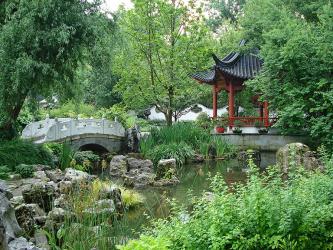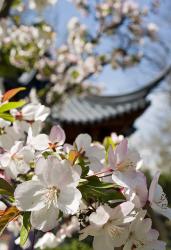It is often said that a Chinese garden is built, not planted. Designed by Chinese-born architect Yong Pan, this garden is a showplace of extraordinary craftsmanship. The architectural elements were designed and built using the traditional colors indicative of a southern Chinese Garden: black, white, gray and reddish brown for the different elements such as the walls, pavilion, bridges, and blue stone pavings with their exquisite mosaic designs. The Chinese term for landscape is shan shui, literally “mountains and water.” Water is the yin, the calm, nurturing, yielding element; mountains are the complementary yang, vertical and powerful. The garden is completed with a body of water, its spiritual heart, and monumental T’ai Hu stones, from the Tai Hu region of China and other nearby regions. These fantastically shaped boulders of eroded limestone serve as nature’s statuary, evoking the awe of ancient mountains, seeming at once solid and transparent, suggesting faces, animals or spiritual forces.
The designer carefully chose traditional plantings, many of which have spiritual significance or value in Chinese culture. Plantings include pines, bamboos, willows, plum trees, forsythia, hibiscus, wisteria, peonies, lotuses, rhododendrons and azaleas, with gardenias, citrus and pen-jing in containers. Many of these plants originated in China, which has the world’s largest temperate flora. A number of them were grown from seed collected in China.
In bloom this month at the Garden: Fringe trees, Mountain bluets, Hellebores, St. John’s wort, lilies.







